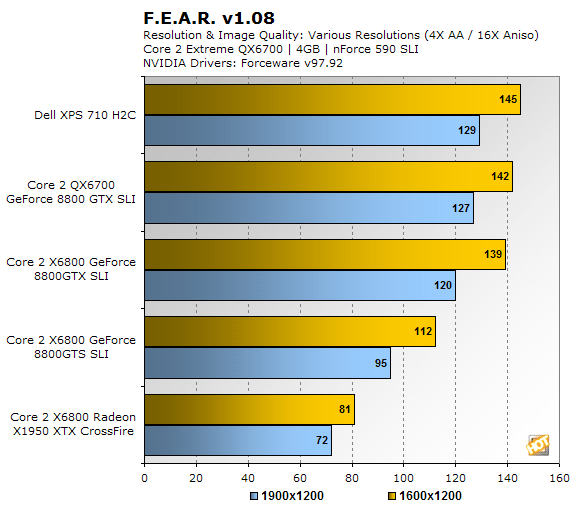
By now you've gotten the gist that we have no intention of testing the Dell XPS 710 H2C at anything less than 1600X1200 resolution, and why should we? With the multi-GPU and CPU horsepower under its hood, along with its stiff price point, you should expect nothing but ultra high-end performance in ultra high-end test conditions. We will also continue testing at 1900x1200, which is the native resolution of the Dell 2400WFP, a brilliant 24" screen that would make a worthy companion for the XPS 710 H2C.

|
|
Performance Comparisons with F.E.A.R
|
|
More Info: http://www.whatisfear.com/us/
|
|

F.E.A.R
|
One of the most highly anticipated titles of 2005 was Monolith's paranormal thriller F.E.A.R. Taking a look at the minimum system requirements, we see that you will need at least a 1.7GHz Pentium 4 with 512MB of system memory and a 64MB graphics card, that is a Radeon 9000 or GeForce4 Ti-class or better, to adequately run the game. Using the full retail release of the game patched to v1.08, we put the graphics cards in this review through their paces to see how they fared with a popular title. Here, all graphics settings within the game were set to the maximum values, but with soft shadows disabled (Soft shadows and anti-aliasing do not work together currently). Benchmark runs were then completed at a resolution 1600x1200 then again at 1900x1200, with anti-aliasing and anisotropic filtering enabled.
|

At these settings F.E.A.R. used to invoke horror into even the most powerful of GPUs, that is until the NVIDIA 8800 GTX appeared on the scene. All three systems equipped with GeForce 8800 GTXs in SLI posted 100+ fps at both resolutions. Our Radeon equipped system didn't do so well and only achieved half the fps as the 8800 GTX systems, however the game was still very playable. Also, once again, the Dell XPS 710 H2C took top honors.

|
|
Performance Comparisons with Prey
|
|
Details: http://www.prey.com/
|
|
 Prey
Prey
|
After many years of development, Take-Two Interactive recently released the highly anticipated game Prey. Prey is based upon an updated and modified version of the Doom 3 engine, and as such performance characteristics between the two titles are very similar. Like Doom 3, Prey is also an OpenGL game that uses extremely high-detailed textures and a plethora of dynamic lighting and shadows. But unlike Doom3, Prey features a fare share of outdoor environments as well. We ran these Prey benchmarks using a custom recorded timedemo with the game set to its "High-Quality" graphics mode, at resolutions of 1600 x 1200 and 1900 x 1200 with 4X AA and 16X anisotropic filtering enabled simultaneously.
|

We see more of the same story in our Prey tests. Since both Prey and Quake 4 are built on a Doom 3 engine foundation, its not surprising to see similar trends in the two sets of benchmark results.

|
|
Performance Comparisons with Half-Life 2: Episode 1
|
|
Details: http://www.half-life2.com/
|
|
 Half Life 2: Episode 1
Half Life 2: Episode 1
|
Thanks to the dedication of hardcore PC gamers and a huge mod-community, the original Half-Life became one of the most successful first person shooters of all time. So, when Valve announced Half-Life 2 was close to completion, gamers the world over sat in eager anticipation. Upon its release, HL2 was universally lauded, and the sequel won an array of "Game of the Year" awards. Armed with the latest episodic update to HL2, Episode 1, we benchmarked the game with a long, custom-recorded timedemo that takes us through both outdoor and indoor environments. These tests were run at resolutions of 1600 x 1200 and 1900 x 1200 with 4X anti-aliasing and 16X anisotropic filtering enabled concurrently, and with color correction and HDR rendering enabled in the game engine as well.
|

The Source engine seems to be better able to utilize more than two cores, since the two quad-core equipped systems have a clear advantage over the similarly configured dual-core X6800 system but then again, this game engine is far less GPU-intensive. Regardless, the XPS 710 H2C once again takes first place by a solid margin.













